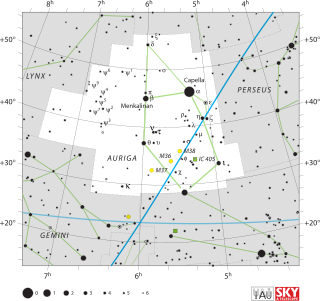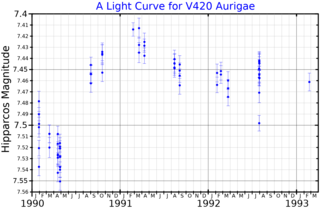Related Research Articles

36 Ophiuchi is a triple star system 19.5 light-years from Earth. It is in the constellation Ophiuchus.

Pi Aurigae, Latinized from π Aurigae, is the Bayer designation for a single, red-hued star in the northern constellation of Auriga. Located about one degree north of the 2nd magnitude star Beta Aurigae, Pi Aurigae is visible to the naked eye with an apparent visual magnitude of 4.25 Based upon parallax measurements, it is approximately 780 light-years away from Earth. At that distance, the brightness of the star is diminished by 0.54 in magnitude from extinction caused by interstellar gas and dust.

9 Aurigae is a star system in Auriga (constellation). It has an apparent magnitude of about 5, making it visible to the naked eye in many suburban skies. Parallax estimates made by the Hipparcos spacecraft put it at about 86 light-years from the solar system, although individual Gaia Data Release 3 parallaxes place all three components at 88 light years.

UU Aurigae is a carbon star in the constellation Auriga. It is approximately 341 parsecs from Earth.

54 Aurigae is a multiple star system located around 800 light-years (51,000,000 AU) away from the Sun in the northern constellation of Auriga. It is visible to the naked eye as a dim, blue-white hued star with a combined apparent visual magnitude of 6.02. The system is moving further from the Sun with a heliocentric radial velocity of around +19 km/s.

59 Aurigae, often abbreviated as 59 Aur, is a star in the constellation Auriga. Its baseline apparent magnitude is 6.1, meaning it can just barely be seen with the naked eye as a dim, yellow-white hued star. Based on parallax measurements, it is located about 483 light-years away from the Sun.
40 Boötis is a single star located 166.5 light years away from the Sun in the northern constellation of Boötes. It is visible to the naked eye as a dim, yellow-white hued star with an apparent visual magnitude of 5.64. The star is moving away from the Earth with a heliocentric radial velocity of +12 km/s.
HD 221776 is a double star in the northern constellation of Andromeda. With an apparent visual magnitude of 6.18, it is viewable by the naked eye user very favourable conditions. The most luminous component has a spectral classification K5III, meaning that it is an orange giant star that has evolved off the main sequence. An infrared excess has been detected around this star, indicating the star is associated with a cloud of dust particles.

V420 Aurigae is a high-mass star with an inferred compact companion. Closely orbiting each other every 0.8 days, they are a source of X-ray emission.

HD 32188 is suspected variable star in the northern constellation of Auriga, and is positioned roughly in between Eta and Zeta Aurigae. It has a white hue and is just barely visible to the naked eye with an apparent visual magnitude that fluctuates around 6.08. The distance to this star is approximately 3,000 light years, based on parallax. It has an absolute magnitude of −2.87.

V352 Aurigae is a variable star in the northern constellation of Auriga. It dimly visible to the naked eye with an apparent visual magnitude that ranges from 6.13 down to 6.18. According to the Bortle scale, it is faintly visible to the naked eye from dark rural skies. The star is located at a distance of approximately 970 light years from the Sun based on parallax, but is drifting closer with a radial velocity of −7 km/s.

V538 Aurigae is a single star in the northern constellation of Auriga. With an apparent visual magnitude of 6.23, this star requires good dark sky conditions to view with the naked eye. It is located at a distance of 40.0 light-years (12.3 pc) from Sun based on parallax. The star is drifting further away with a radial velocity of 0.9 km/s. It is a member of the Local Association, and is most likely a thin disk star.

NO Aurigae is a pulsating variable star in the constellation Auriga. It is an unusually-luminous asymptotic giant branch star about 3,500 light years away.
HD 135438 is a K-type giant star in the northern constellation of Boötes. With an apparent magnitude of 6.0, it lies about 650 light years away.

Theta Delphini, a name Latinized from θ Delphini, is a single star in the northern constellation of Delphinus. It has an apparent visual magnitude of about 5.7, meaning that it is just barely visible to the naked eye under excellent viewing conditions. The distance to this star is approximately 2,050 light years from the Sun based on parallax. It is drifting closer with a radial velocity of −15 km/s.
8 Persei is a single star in the northern constellation of Perseus, located 416 light years away from the Sun. It is visible to the naked eye as a dim, orange-hued star with an apparent visual magnitude of 5.757. There is an estimated 52% chance that the star may be a member of the Hyades–Pleiades stream of co-moving stars.

V915 Scorpii is an orange hypergiant variable star in the constellation Scorpius.

12 Pegasi is a K-type supergiant star in the constellation of Pegasus. It has a spectral type of K0Ib Hdel0.5, which indicates that it is a less luminous K-type supergiant with strong H-δ Balmer lines. The star has expanded to 81 times the radius of the Sun, and has an effective temperature of 4,185 K.

HD 199223 is a double star in the equatorial constellation Delphinus. However, the system was originally in Equuleus prior to the creation of official IAU constellation borders. The components have a separation of 2″ at a position angle of 282° as of 2016. They have apparent magnitudes of 6.34 and 7.49 and distances of 354 and 359 light years respectively. The system is drifting closer with a radial velocity of −33 km/s.

RS Sagittarii is an eclipsing binary star system in the southern constellation of Sagittarius, abbreviated RS Sgr. It is a double-lined spectroscopic binary with an orbital period of 2.416 days, indicating that the components are too close to each other to be individually resolved. The system has a combined apparent visual magnitude of 6.01, which is bright enough to be faintly visible to the naked eye. During the primary eclipse the brightness drops to magnitude 6.97, while the secondary eclipse is of magnitude 6.28. The distance to this system is approximately 1,420 light years based on parallax measurements.
References
- 1 2 3 4 5 Vallenari, A.; et al. (Gaia Collaboration) (2022). "Gaia Data Release 3. Summary of the content and survey properties". Astronomy & Astrophysics . arXiv: 2208.00211 . doi: 10.1051/0004-6361/202243940 . Gaia DR3 record for this source at VizieR.
- 1 2 Paunzen, E. (2015). "A new catalogue of Strömgren-Crawford uvbyβ photometry". Astronomy & Astrophysics. 580: A23. arXiv: 1506.04568 . Bibcode:2015A&A...580A..23P. doi:10.1051/0004-6361/201526413. S2CID 73623700.
- ↑ Burbidge, G. R.; Burbidge, E. Margaret (September 1953). "The Balmer Decrement in Some Be Stars". Astrophysical Journal. 118: 252. Bibcode:1953ApJ...118..252B. doi: 10.1086/145747 .
- 1 2 3 4 5 Anders, F.; Khalatyan, A.; Queiroz, A. B. A.; Chiappini, C.; Ardevol, J.; Casamiquela, L.; Figueras, F.; Jimenez-Arranz, O.; Jordi, C.; Monguio, M.; Romero-Gomez, M.; Altamirano, D.; Antoja, T.; Assaad, R.; Cantat-Gaudin, T.; Castro-Ginard, A.; Enke, H.; Girardi, L.; Guiglion, G.; Khan, S.; Luri, X.; Miglio, A.; Minchev, I.; Ramos, P.; Santiago, B. X.; Steinmetz, M. (2022). "VizieR Online Data Catalog: StarHorse2, Gaia EDR3 photo-astrometric distances (Anders+, 2022)". Vizier Online Data Catalog. Bibcode:2022yCat.1354....0A.
- 1 2 3 4 McDonald, I.; Zijlstra, A. A.; Watson, R. A. (15 June 2017). "Fundamental parameters and infrared excesses of Tycho–Gaia stars". Monthly Notices of the Royal Astronomical Society. 471 (1): 770–791. arXiv: 1706.02208 . Bibcode:2017MNRAS.471..770M. doi: 10.1093/mnras/stx1433 . eISSN 1365-2966. ISSN 0035-8711.
- 1 2 3 4 Stassun, Keivan G.; et al. (September 2018). "The TESS Input Catalog and Candidate Target List". The Astronomical Journal. 156 (3): 102. arXiv: 1706.00495 . Bibcode:2018AJ....156..102S. doi: 10.3847/1538-3881/aad050 . ISSN 0004-6256.
- ↑ Halbedel, Elaine M. (September 1996). "Rotational Velocity Determinations for 164 Be and B Stars". Publications of the Astronomical Society of the Pacific. 108: 833. Bibcode:1996PASP..108..833H. doi: 10.1086/133804 .
- 1 2 "12 Aur". SIMBAD . Centre de données astronomiques de Strasbourg . Retrieved 2019-04-04.
- ↑ Halbedel, Elaine M. (September 1996). "Rotational Velocity Determinations for 164 Be and B Stars". Publications of the Astronomical Society of the Pacific. 108: 833. Bibcode:1996PASP..108..833H. doi: 10.1086/133804 . S2CID 119944672.
- ↑ Hamdy, M. A.; Elazm, M. S. A.; Saad, S. M. (1991). "Spectral reclassification of some be stars using ΔQ method". Astrophysics and Space Science. 186 (1): 161. Bibcode:1991Ap&SS.186..161H. doi:10.1007/BF00644632. S2CID 123509301.
- ↑ Wright, Candace O.; et al. (2003). "The Tycho-2 Spectral Type Catalog". The Astronomical Journal. 125 (1): 359. Bibcode:2003AJ....125..359W. doi: 10.1086/345511 . S2CID 122781581.